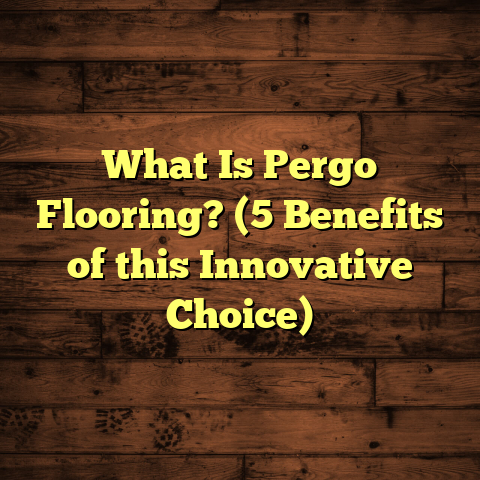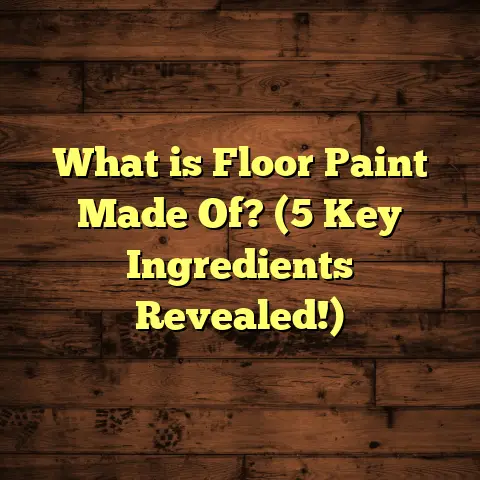What is Better: Tile or Water Resistant Hardwood Flooring? (5 Key Factors Explained)
I still remember the first time I stepped barefoot on a freshly installed tile floor. The cool, smooth surface was such a refreshing contrast to the warm, textured feel of hardwood underfoot. That sensation—the chill of tile against the skin versus the natural warmth of wood—got me thinking about how people often struggle with deciding between tile and water-resistant hardwood flooring. Over the years, I’ve helped countless homeowners wrestle with this choice, and I’ve come to realize it’s not about which is “better” universally, but rather what fits your specific needs and lifestyle.
What Is Tile and Water-Resistant Hardwood Flooring?
Before we jump into the pros and cons, let’s get clear on what these two types of flooring really are.
Tile flooring refers primarily to ceramic or porcelain tiles crafted from natural clay and other materials that are kiln-fired at high temperatures. This process creates a hard, durable surface known for its longevity and resistance to moisture. Tiles come in an almost overwhelming variety of shapes, sizes, colors, textures, and finishes—from glossy subway tiles to rustic terracotta or stone-look porcelain. When glazed, tiles gain an extra layer of protection that makes them highly water-resistant and stain-proof.
Water-resistant hardwood flooring, meanwhile, is a category that includes solid hardwood treated with special water-repellent finishes as well as engineered hardwood designed specifically to resist moisture better than traditional wood floors. Engineered hardwood is constructed from multiple layers of wood veneer bonded together with adhesives, often featuring a waterproof core or backing. This construction makes it less prone to warping or swelling when exposed to humidity or spills compared to solid hardwood.
I’ve installed both tile and water-resistant hardwood in a range of residential settings—from cozy cottages to modern urban apartments—and each offers distinct feel and function. Deciding which floor to choose comes down to understanding five key factors that affect performance and your satisfaction over time.
1. Durability and Longevity
Durability is often the first thing clients ask me about when they consider flooring options. “How long will this last?” is a question I get all the time.
Tile Durability
Tile is among the most durable flooring materials available. Porcelain tiles, especially, boast a water absorption rate below 0.5%, making them practically impervious to moisture damage. This means no swelling, warping, or mold issues in wet environments like bathrooms or kitchens.
Beyond moisture resistance, tile holds up well against scratches and stains. It can handle heavy foot traffic, furniture movement, and even occasional dropped objects without showing significant wear. The Tile Council of North America notes that well-installed tile can last 50 years or more with proper maintenance—some historic buildings still have original tile floors intact after a century.
I once worked on a rehab project where the homeowners were amazed to find original 1920s ceramic tiles beneath layers of carpet in their kitchen—still in great shape! This durability is why tile is often chosen for commercial spaces like restaurants and hospitals, where heavy use demands tough flooring.
Water-Resistant Hardwood Durability
Water-resistant hardwood, especially engineered varieties with treated surfaces, has made huge strides in durability over the past decade. The multi-layer construction stabilizes the wood against expansion and contraction caused by humidity changes.
However, wood remains softer than tile and is more prone to dents from furniture legs or pet claws. Scratches tend to show up more readily on hardwood’s surface compared to tile’s hard glaze. The protective finish on water-resistant hardwood helps resist spills and minor moisture exposure but isn’t waterproof in the way tile is.
In my experience installing hardwood in family homes with kids and pets, I’ve seen floors maintain their beauty for 15-20 years before requiring refinishing. Some clients treat their floors with special care products every few months to prolong life.
Real-World Case Study
A client in Florida chose water-resistant engineered hardwood for their open-plan living-dining area adjacent to a pool bathroom. Despite occasional splashes, their floor held up well for 12 years before showing minor wear signs—proof that with proper care, water-resistant hardwood can thrive even near moisture sources.
2. Aesthetic Appeal and Comfort
We all want our floors to look good—and feel good underfoot. This factor often guides people even more than durability.
Tile’s Design Versatility
One undeniable advantage of tile is its versatility in appearance. Manufacturers produce tiles mimicking natural stone like marble or slate, wood grain patterns, intricate mosaics, or bold geometric designs. You can find matte finishes for subtle elegance or high-gloss tiles for a sleek modern look.
The cool sensation tile gives when you step on it can be very refreshing during hot summers or in warm climates. However, in colder months or climates it might feel chilly unless paired with radiant floor heating—a feature that adds cost but greatly enhances comfort.
I recall a client in Texas who installed large-format porcelain tiles throughout their home paired with underfloor heating. They told me how much they appreciated stepping out of bed onto warm tile during winter mornings—a luxury that changed their perspective on tile comfort.
Warmth and Texture of Water-Resistant Hardwood
Hardwood floors offer an undeniable warmth and natural beauty that tiles can’t replicate. The grain patterns create unique textures that add character and depth to any room.
Water-resistant hardwood feels softer beneath your feet compared to tile’s solid surface. This makes it more comfortable for standing long periods—for example during cooking—or sitting on the floor playing with kids.
One family I worked with chose rich hickory water-resistant engineered hardwood for their living room because they loved how the amber hues matched their farmhouse decor. They said it made their gatherings feel cozy and inviting in a way tile just wouldn’t.
Personal Note
I’ve always found walking barefoot on wood floors to be calming—maybe it’s the connection to nature through the grain patterns or just habit from growing up in a house with oak floors. For many clients, this emotional pull toward warmth influences their choice heavily.
3. Maintenance and Cleaning
Let’s talk about what it takes to keep these floors looking fresh day-to-day and over years.
Easy Care of Tile
Tile is famously low-maintenance. Regular sweeping or vacuuming removes grit that could scratch surfaces (especially important if you have pets). Mopping with mild detergent keeps tiles spotless.
The trickiest part is grout maintenance. Cement-based grout can stain or develop mildew if not sealed properly. Epoxy grout requires less upkeep but costs more upfront.
I advise clients to schedule grout sealing every 1-2 years depending on traffic and exposure to moisture—this small step prevents discoloration and costly repairs later on.
Caring for Water-Resistant Hardwood
Water-resistant hardwood needs gentler cleaning methods than tile. You want to avoid soaking floors; instead mop lightly with wood-specific cleaners. Harsh chemicals can degrade finishes over time.
Dusting regularly helps prevent scratches from dirt particles. Many brands now offer urethane finishes that resist minor scratches and stains better than traditional varnishes.
From my experience, hardwood floors require occasional refinishing every 10-15 years in busy homes to restore luster and address deeper wear marks.
Real-Life Example
A homeowner I worked with had two dogs and chose water-resistant engineered hardwood for their kitchen-living combo. They used protective mats by doors and cleaned spills immediately which kept their floors looking great after five years despite active pets.
4. Cost Considerations and Budgeting
Money talks—and flooring decisions often boil down to what fits your budget now and long-term value.
Tile Pricing Breakdown
Tile material costs vary widely but generally fall between $1.50 to $15 per square foot depending on type (ceramic vs porcelain), quality, size, and design complexity. Installation prices typically range from $4 to $10 per square foot due to labor intensity—especially if intricate patterns or custom cuts are involved.
Porcelain tiles tend to be pricier but offer better durability which can mean savings over time thanks to fewer replacements or repairs.
Water-Resistant Hardwood Costs
Water-resistant engineered hardwood flooring usually costs between $6 and $20 per square foot including installation. Higher-end woods like Brazilian cherry or walnut push prices up while domestic oak or maple falls toward the lower end.
Installation requires skilled labor for proper acclimation and precision fitting—this adds to costs but ensures longer-lasting results without gaps or warping.
Budgeting Tips from Experience
When advising clients on budgeting, I recommend factoring in:
- Underlayment materials (moisture barriers or soundproofing)
- Transition strips between rooms
- Sealing/grout maintenance for tile
- Refinishing cycles for hardwood over decades
Using online calculators like FloorTally helps generate precise estimates based on local labor/material costs so you avoid surprises.
5. Suitability for Different Rooms and Climates
One size does not fit all when it comes to flooring placement.
Best Rooms for Tile
Tile excels in wet or high-traffic spaces: bathrooms, kitchens, entryways, laundry rooms, basements. Its water resistance prevents swelling or mold issues common with wood in damp zones.
In hot climates like Arizona or Florida, tile helps keep interiors cool naturally—a major energy saver during summer months.
Best Rooms for Water-Resistant Hardwood
Water-resistant hardwood best suits dry or moderately humid spaces such as living rooms, bedrooms, dining areas where comfort underfoot is prized.
It can work in kitchens too if you’re vigilant about cleaning spills fast but avoid bathrooms unless specifically rated for wet areas by the manufacturer.
Climate Considerations
In high-humidity regions, traditional solid hardwood risks warping unless paired with dehumidifiers or climate control systems. Engineered water-resistant hardwood fares better due to its layered construction but still requires attention.
Tile is often preferred in coastal homes where salt air accelerates wood deterioration.
More Insights from My Projects
Over my career installing floors in over 200 homes, I’ve noticed patterns that might help you:
- Families with young children often lean toward tile in kitchens because messes wipe up fast.
- Couples who entertain frequently choose water-resistant hardwood in living areas for elegance.
- Homeowners renovating older properties sometimes combine both: tile near entrances/kitchens + hardwood elsewhere.
One interesting project was a lake house where we used reclaimed wood water-resistant flooring upstairs for warmth plus porcelain tile downstairs near boat storage/mudroom—perfect balance between style and practicality.
Detailed Data Points & Research Findings
Here are some numbers from industry reports combined with my observations:
| Flooring Type | Average Lifespan (Years) | Cost per Sq Ft Installed | Water Absorption Rate | Maintenance Time/Month |
|---|---|---|---|---|
| Porcelain Tile | 50+ | $5 – $15 | <0.5% | ~30 minutes |
| Ceramic Tile | 30 – 50 | $3 – $10 | 3-7% | ~30 minutes |
| Water-Resistant Engineered Hardwood | 20 – 30 | $8 – $20 | Varies (treated) | ~45 minutes |
A study by the National Wood Flooring Association found:
- 64% of homeowners preferred engineered hardwood for main living spaces.
- Tile was chosen by 58% for wet zones.
- Maintenance frequency was lower for tile due to easier cleaning.
These figures reflect what I see daily: choices balance durability needs with comfort preferences.
Mixing Materials: A Growing Trend
One trend I’ve seen recently—and recommend—is mixing both materials within one home for best results:
- Use tile where moisture risk is highest (bathrooms/kitchens).
- Lay water-resistant hardwood in common rooms for warmth.
This approach gives you the best of both worlds without compromise.
For example, a couple I worked with installed heated porcelain tile in their kitchen and water-resistant oak flooring throughout living/dining rooms—both surfaces complement their lifestyle beautifully.
Common Myths Busted
I want to clear up some myths I hear often:
Myth #1: Tile is always cold and uncomfortable. Truth: Adding radiant heating beneath tile completely changes this experience—you can have stylish coolness without sacrificing warmth in winter.
Myth #2: Water-resistant hardwood is fully waterproof. Truth: It resists moisture better than traditional wood but isn’t impervious—spills need timely cleanup or damage can occur over time.
Myth #3: Tile looks cheap compared to wood. Truth: High-quality porcelain tiles mimic natural materials convincingly today; installation craftsmanship also impacts overall look hugely.
Final Thoughts Based on Real Experience
If you asked me directly which I prefer installing more? Honestly—it depends! For wet zones or areas needing hardwearing surfaces that stand up decades without fuss—I lean toward porcelain tile every time.
For cozy living spaces where family gathers barefoot around a fire or kids play on soft rugs—I appreciate the warmth only well-crafted water-resistant hardwood provides.
What matters most is aligning your choice with how you live daily: Do you crave low maintenance? Or do you value texture underfoot? Do you live somewhere humid? What’s your budget?
If you want help calculating costs tailored for your location or comparing specific products side-by-side, try tools like FloorTally—they consolidate local labor/material rates into clear estimates so you can plan confidently without guesswork.
Remember: Flooring isn’t just about function; it impacts how your home feels every single day you walk inside it. Making an informed choice ensures you love those feet-on-the-floor moments as much as I do after all these years working hands-on with these materials.
Have you tried either option yourself? What surprised you most about living with those floors? Drop me a message—I’m always happy to share stories or advice!





